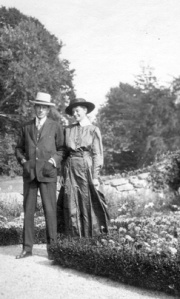A Trip to New Orleans
Have you ever marveled at the different ways men and women see historic sites? Here at Blithewold, Docents have to be prepared to answer very different questions from visitors. Marjorie Lyon, herself, was well aware of this disparity, and in 1917 she wrote an amusing ‘imagined’ conversation about a sightseeing trip she and George made to New Orleans. The exchange is between Marjorie and George and their tour-guide/chauffeur.
MARJORIE: What a quaint city, and such narrow streets!
GEORGE: What did you say was the population of New Orleans?
MARJORIE: Just look at that fascinating doorway!
GEORGE: You know I don’t want to miss seeing those Port Commission docks.
MARJORIE: See that old square-rigged Danish ship with its figurehead!
GEORGE: Yes. What is the depth of the river here, Chauffeur, and how far did you say we were from the Gulf?
As the motor journeys to the old French Quarter, Marjorie gazes at cobblestoned streets, flower-filled courtyards, and old world houses; while George finds out the make of the car, the state of the roads around New Orleans, the names of the exclusive clubs, the amount of money per capita per citizen – not to mention the size of Lake Ponchartrain, and the number of feet its tide rises.
MARJORIE: There is a building that looks hundreds of years old. What an air of mystery there is about it!
GEORGE: It was built in 1828 on the 16th of May at four o’clock in the afternoon.
MARJORIE: And look at those picturesque old wooden houses with the dormer windows!
GEORGE: Regular fire traps!
MARJORIE: What exquisite iron grille work – surely a Spanish senorita would be in hiding there!
GEORGE: Yes. (To Chauffeur) When was this present modern system of sewerage installed?
MARJORIE: This must be the park that used to be an old plantation – what beautiful live oaks!
GEORGE: What is the exact area of this park?
On the homeward trip Marjorie continues to admire the old slate roofs, tiny Italian shops, and the quaint turns and twists in the old streets; while George finds out how cold it gets in winter, what the density of the air is above the City, and how many people are buried in all six of the cemeteries.

